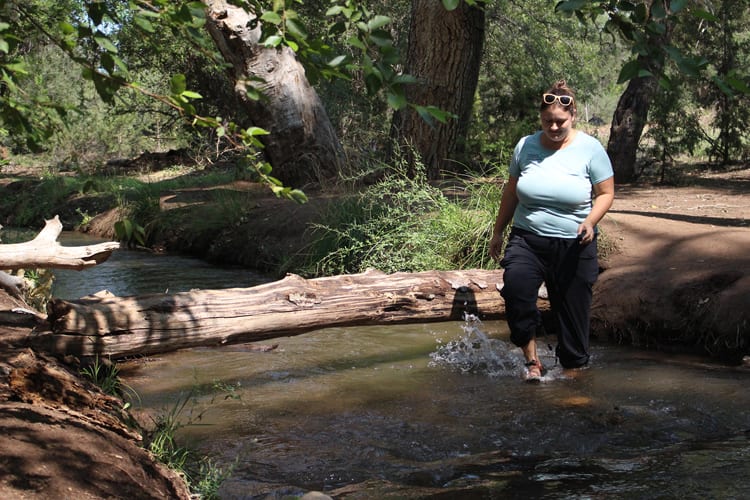You may be familiar with carbon offsets, in which companies or schools try to reduce greenhouse gas emissions in one area to make up for emissions elsewhere. More and more, corporations also are trying to offset the water they use.
The Intel Corp., for one, announced a water restoration goal last year: restore 100 percent of its direct global water use by 2025. It employs about 10,000 people in the Phoenix area and has offices around the world.
Company officials said Intel already restores about 80 percent of the water it uses, and it is funding projects to make up for that final 20 percent.
One of those projects brought Intel to West Clear Creek, about two hours northeast of Phoenix, near Camp Verde.
On a warm morning this summer, Kimberly Schonek, the Verde River program director at the environmental group Nature Conservancy, drove past farm fields bisected by a burbling stream.
“As you can see, West Clear Creek is flowing today,” she said. “And the reason that it’s flowing is we’ve had lots of monsoons.”
The Nature Conservancy, with funding from Intel, is laying pipe to replace the earthen ditch that diverts creek water to nearby farm fields. A pipe will save the water that’s now seeping into the ground. The saved water can remain in the creek and make its way to the Verde River.
“If you can put infrastructure in place that reduces (the farmers’) demand for how it gets from the river to their farm, then you’re saving water in that reach of the river,” Schonek said.
When finished, Intel can apply some of the saved water toward its restoration goal. The company is trying to be “water neutral,” so to speak, and it has hired an outside engineering firm to help calculate its progress.
“For us, it’s part of our business strategy to make sure that we have access to water,” said Fawn Bergen, global sustainability program manager at Intel. “But it is broader than that. It’s also our commitment to sustainability and corporate responsibility. It’s not just like a transaction.”
Water is a growing concern for many companies, said Cate Lamb, director of water security at the environmental nonprofit CDP, which pushes for corporate data disclosure.
“We’re seeing certain organizations and many, many companies facing the reality that that stable supply of water that they need for their business can no longer be guaranteed in many regions,” Lamb said.
Lamb acknowledged, however, that there isn’t one universal standard for what a company is responsible for. Intel’s restoration goal is based on the water it directly uses at its sites. The company isn’t trying to restore the water used in its supply chain – at least not yet. The computer chip maker says it monitors suppliers in other ways to encourage good water practices.
That’s not an acceptable answer, said Rick Hogeboom, executive director of the nonprofit Water Footprint Network. He describes the supply chain as “something that many companies are fully unaware of, and also don’t feel very responsible for.”
The network came up with a specific metric for calculating a company’s “water footprint.” It includes water taken from various sources as well as the water needed to dilute discharges safely into the environment. Without accounting for the water in the supply chain, Hogeboom said, you don’t get the whole picture of a product.
“It’s very important to have this one framework so that we know that we are on the same page, and not have these semantic discussions all the time,” he said.
And yet others caution not to let the perfect be the enemy of the good. John Sabo, director of Future H2O at Arizona State University, said standards by themselves will not change water practices.
“You need a leader like a Coca-Cola, like an Intel, who’s going to go out (and) invest money outside their four walls,” said Sabo, who has worked as an unpaid consultant with Coca-Cola on water-sustainability issues. He said leading companies can “influence other players who may have more money, like other companies and the public sector.”
Lamb agreed, but she emphasized that the investors she works with want to make real efforts to improve water security.
“At the moment, because there is this lack of standardized approaches and standard definitions of what this looks like, it’s hard to say,” she said. “It’s almost like that’s the next frontier that we’re exploring as a community.”
As water stress increases around the world, water use may move from the frontier of the conversation to the center.




